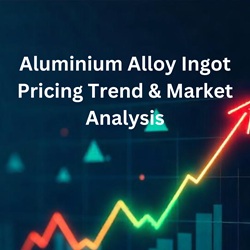
Aluminum Alloy Ingot Pricing Foreca
Aluminum alloy ingots are a critical component in the production of lightweight materials across various industries, including automotive, construction, and aerospace. As we move into 2025, understanding the pricing trends for aluminum alloy ingots becomes crucial for businesses that rely on this essential material. In this article, we will explore the factors that will influence aluminum alloy ingot prices in 2025 and provide a forecast for the market in the coming year.
What Are Aluminum Alloy Ingots?
Aluminum alloy ingots are solidified blocks of aluminum that have been combined with other metals to create an alloy. These ingots are the primary form of aluminum used in manufacturing and are highly sought after due to their durability, light weight, and resistance to corrosion. Aluminum alloys are used in a wide range of applications, from lightweight car parts and aircraft components to building materials in construction projects.
The price of aluminum alloy ingots is influenced by various factors, including global demand, production costs, and external economic conditions. As we approach 2025, businesses and manufacturers need to stay informed about these trends to make strategic decisions about sourcing and pricing.
Book a Demo for a real-time, data-driven insights: https://www.price-watch.ai/book-a-demo/
Factors Impacting Aluminum Alloy Ingot Prices in 2025
1. Global Demand for Aluminum
Global demand for aluminum is projected to rise in 2025, driven by growth in industries like automotive and construction. The automotive industry, in particular, has been increasing its use of aluminum to reduce vehicle weight and improve fuel efficiency. This trend is expected to continue as manufacturers strive to meet stricter environmental regulations and consumer demand for more fuel-efficient vehicles.
The construction industry is also expected to see strong growth, especially in emerging economies where urbanization and infrastructure development are on the rise. Aluminum alloys are used extensively in construction for materials like windows, doors, and facades. As demand from these sectors increases, the price of aluminum alloy ingots is likely to rise as well.
2. Energy Prices and Production Costs
Aluminum production is energy-intensive, and energy prices are a major factor influencing the cost of aluminum alloy ingots. The price of electricity and fuel required for smelting aluminum has a direct impact on production costs. In 2025, fluctuations in energy prices could cause significant changes in aluminum prices.
If energy prices rise due to increased global demand or geopolitical tensions, the cost of aluminum alloy production will likely increase, leading to higher prices for ingots. On the other hand, if energy prices stabilize or fall due to advancements in energy efficiency or the adoption of renewable energy sources, it could help to mitigate price increases.
3. Geopolitical Issues and Trade Relations
Aluminum is a globally traded commodity, and geopolitical factors play a significant role in shaping prices. Trade relations between major aluminum producers, such as China, Russia, and the United States, can have a profound effect on the global supply chain.
For example, if trade policies change or countries impose tariffs on aluminum imports, the cost of aluminum alloy ingots could rise. Geopolitical instability in key aluminum-producing countries could also disrupt supply chains, leading to shortages and price hikes. These uncertainties make it important for manufacturers to closely monitor global political developments.
4. Environmental Regulations and Sustainability Pressures
As governments around the world tighten environmental regulations to combat climate change, aluminum producers will be required to adopt more sustainable production methods. This could involve increased investment in energy-efficient technologies or cleaner manufacturing processes, both of which could increase the cost of production.
Additionally, there is a growing push for aluminum recycling, which requires less energy than primary production. In 2025, the growth of the recycling industry could help to stabilize prices by providing an alternative to primary aluminum. However, if recycled aluminum becomes more expensive or less available, it could lead to higher prices for alloy ingots.
5. Technological Innovation and Production Efficiency
Advancements in aluminum production technologies, such as improvements in smelting processes and increased recycling capabilities, could have a significant impact on aluminum prices. More efficient production techniques could reduce the overall cost of aluminum alloy ingots, helping to stabilize or even lower prices.
In particular, increased use of recycled aluminum could alleviate some of the pressure on primary aluminum production, helping to balance supply and demand. If these technologies become more widespread in 2025, they could lead to more predictable pricing in the aluminum market.
Aluminum Alloy Ingot Price Outlook for 2025
Taking all of these factors into account, it is likely that aluminum alloy ingot prices will experience upward pressure in 2025. Increased demand from key industries, combined with rising energy costs and geopolitical uncertainties, will contribute to higher prices. However, technological advancements in production efficiency and recycling could help stabilize prices and prevent excessive price hikes.
In conclusion, the pricing trend for aluminum alloy ingots in 2025 will be influenced by several key factors, including global demand, energy prices, geopolitical factors, and sustainability efforts. While the demand for aluminum alloys will likely drive prices up, innovations in production technology and increased recycling efforts could help to stabilize the market. By staying informed about these trends, businesses can make better decisions about sourcing materials and managing costs in 2025.









